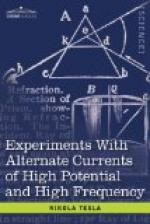Now compare this phenomenon which you have just witnessed with the discharge of a Holtz or Wimshurst machine—that other interesting appliance so dear to the experimenter. What a difference there is between these phenomena! And yet, had I made the necessary arrangements—which could have been made easily, were it not that they would interfere with other experiments—I could have produced with this coil sparks which, had I the coil hidden from your view and only two knobs exposed, even the keenest observer among you would find it difficult, if not impossible, to distinguish from those of an influence or friction machine. This may be done in many ways—for instance, by operating the induction coil which charges the condenser from an alternating-current machine of very low frequency, and preferably adjusting the discharge circuit so that there are no oscillations set up in it. We then obtain in the secondary circuit, if the knobs are of the required size and properly set, a more or less rapid succession of sparks of great intensity and small quantity, which possess the same brilliancy, and are accompanied by the same sharp crackling sound, as those obtained from a friction or influence machine.
Another way is to pass through two primary circuits, having a common secondary, two currents of a slightly different period, which produce in the secondary circuit sparks occurring at comparatively long intervals. But, even with the means at hand this evening, I may succeed in imitating the spark of a Holtz machine. For this purpose I establish between the terminals of the coil which charges the condenser a long, unsteady arc, which is periodically interrupted by the upward current of air produced by it. To increase the current of air I place on each side of the arc, and close to it, a large plate of mica. The condenser charged from this coil discharges into the primary circuit of a second coil through a small air gap, which is necessary to produce a sudden rush of current through the primary. The scheme of connections in the present experiment is indicated in Fig. 2.
[Illustration: Fig. 2.—Imitating the spark of A Holtz machine.]
G is an ordinarily constructed alternator, supplying the primary P of an induction coil, the secondary S of which charges the condensers or jars cc. The terminals of the secondary are connected to the inside coatings of the jars, the outer coatings being connected to the ends of the primary pp of a second induction coil. This primary pp has a small air gap ab.
The secondary s of this coil is provided with knobs or spheres KK of the proper size and set at a distance suitable for the experiment.
A long arc is established between the terminals ab of the first induction coil. Mm are the mica plates.
Each time the arc is broken between A and B the jars are quickly charged and discharged through the primary pp, producing a snapping spark between the knobs KK. Upon the arc forming between A and B the potential falls, and the jars cannot be charged to such high potential as to break through the air gap ab until the arc is again broken by the draught.




